2015 Darwin Science Expedition - Day 15 - Lagoon Knolls & coconut crabs
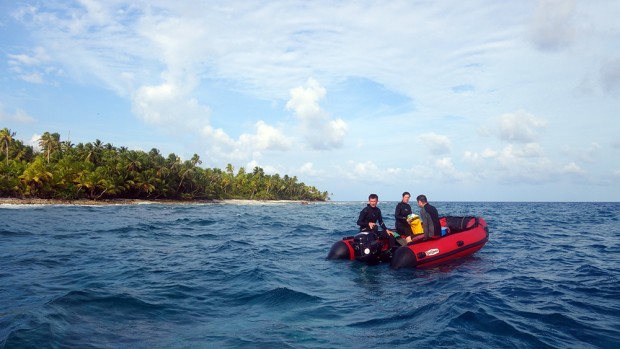
There is plenty to keep everyone occupied on these expeditions. Today saw multiple roles for me and there are several tangents for others too. Firstly safety cover this morning for the first divers of the day as they surveyed the Oceanside reefs of Ile de la Pas. Its hardly a chore to sit atop the boats in the fresh morning enjoying the scenery of the atolls and seabreeze whilst the others get on with work. There was some assisting to be done on their return to the boats as a current had built up with the tide and everyone needed a hand so as not to be swept away whilst removing dive gear.
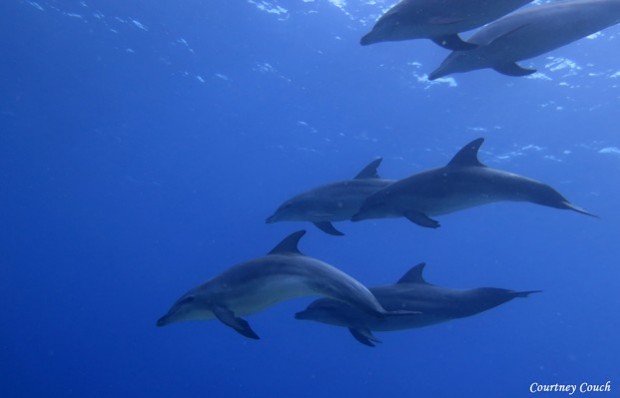
Straight on from there it was out for a dive myself to assist Catherine with retrieving some autonomous reef monitoring systems that had been deployed a couple of years before. During this dive we had the absolute pleasure of a dolphin encounter – as we were working away on the shallow reef I heard the high pitched whistling of dolphin. I immediately waved to Catherine and made for the drop off about 20 meters away and there they were. A pod of about 30 bottlenose dolphin feeding just out in the blue, some rising from the inky depths, others circling passed and spiralling down from the surface in threes and fours. Usually we only see spinner dolphin around salomon and they are far more wary than these bottlenose dolphins were. Their curiosity brought them close to us as they examined what we were before effortlessly sweeping back out into the blue away from the reef. It is worth noting that Charles and Anne recovered more of their temperature recorders from a short distance away and Charles has penned a few words on this strand of field work, before that though I'll finish up with the days endeavours.
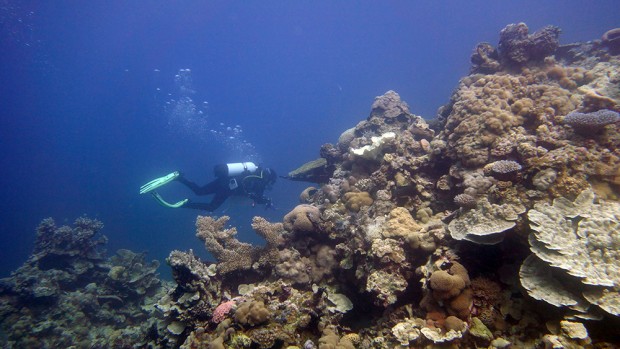
So for Catherine and the various people that helped her the afternoon and evening was taken up by processing the ARMS. For me I broke away and assisted Courtney in her dive on one of the lagoon knolls. The lagoon of salomon Atoll is particularly well sheltered with only one significant small break in the reef on the north east corner. The remainder is protected on all sides by shallow reefs that break the surface at spring low tide. As a result the coral gardens are safe from the most violent of weather and all of the corals grow in a mad variety of colour and structure in a jumble that makes use of every spare space. The knolls crowd toward the surface with corals sprouting out of corals leaning on more corals out of the depths until they create a mound that plateaus just beneath the sea surface.
VIDEO https://www.youtube.com/watch?v=o41TX49gkcU
On one coral head I was treated to the sight of light blue heliopora branches sprouting out of the rosy pink dome of a lobophyllia all crowned with a lace of white seriatopora. A small cloud of jewel like iridescent blue chromis fish shoaled around and between the branches to finish this stunning piece of nature’s art. A turtle offered a close encounter as he lazily rested on the reef allowing my camera within inches of his nose. As I floated up and away to let him carry on with his business three chunky black tip sharks cruised out of the hazy water and circled myself before heading over to investigate Courtney as she surveyed away with her head down to examine the corals, oblivious to the elasmobranch that was investigating her. Return to the research vessel after this lovely afternoon dive did not bring an end to the day…
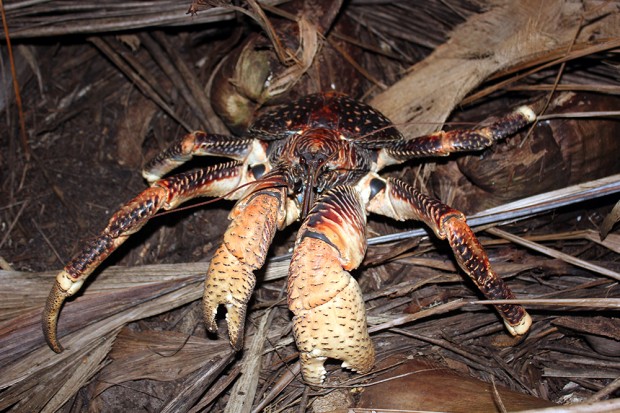
…after some dinner I joined Pete to head onto Ile Anglaise to survey the coconut crab populations there. In contrast to the rat free island, Mapou, that we surveyed earlier in the week, this island is well populated by rodents. The contrast in bird life and night sounds is remarkable. Mapou sounded like a tropical jungle with all manner of cawing, cackling and whistling as seabirds jostled in the hardwood branches overhead. Anglaise was silent except for the occasional rustle of leaves betraying the position of a coconut crab or rat scavenging amongst the leaf litter. Fortunately for the coconut crabs the presence of rats has not disturbed their population and they appear to be on fine form on this island. The trophy crab for our surveys tonight was a huge male weighing in at 2.7 kilograms – best not to tangle with the immense claws on an individual like this. Surveys done we returned to the research vessel by moonlight with a slow motor boat ride across the calm windless lagoon. A busy but fabulous day in Salomon Atoll...carry on reading for an update from Charles on the research stemming from his long term temperature monitors.
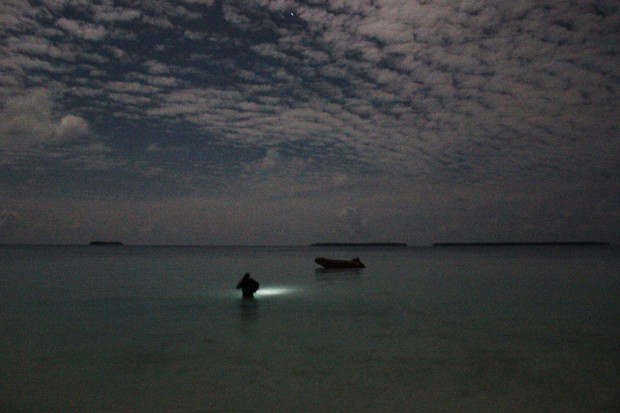
Coral condition and ocean temperatures
Charles Sheppard
For several years past, we have mapped the recovery of corals on reefs of the Chagos following the warm water event of 1998 that killed most of them. For simplicity in presentations I have generally shown the recovery in terms of average coral cover, with data from all sites pooled. Although we keep much data for sites separately and use that in scientific articles, overall the picture of recovery has been similar enough all over the Chagos Archipelago to permit this averaging. We have presented graphs showing this almost annually for several years now, with updates published in Chagos News, at the Chagos day conferences, and other places.
At the same time we have been recording water temperature in several places and depths too, which has shown interesting patterns of rising and falling thermoclines (bands of different temperature water), and we continue to measure these details too.
Until recently the trends have shown a fairly straightforward recovery from the early 2000s, but I don’t think this uniformity is the case any longer – not for this year anyway. In some areas we see the continued recovery, not so much in terms of coral cover now because this is around the maximum that such reefs generally have, but in terms of diversity of the corals growing on the reefs. The initial flush of fast growing table corals is diminishing (with masses of dead tables clearly visible) and these are being replaced by a much greater variety of smaller, boulder shaped corals that are taking their place. This is a process called succession.

North slope of Nelsons Island on the Great Chagos Bank. Almost all the corals here are dead and starting to crumble, with only a very few survivors from whatever killed them over the last year or two.
Clearly such areas can no longer be pooled with the healthy reefs to show any sort of general or averaged pattern. Instead, reefs seem to be going in two different directions: on one hand continuing to look good, with increasing coral diversity, but on the other hand, reverting to a state not seen since the immediate aftermath of the very damaging1998 warming event. Why?
Temperatures may give an answer. This year they are high. This has been predicted since the summer of 2014 in fact, when warnings were issued that ocean temperatures would be higher than ever before. It has not been quite that warm, perhaps, but water is certainly warm in Chagos this year. Using loggers recording at 1 minute intervals that record to two decimal places of a degree, as well as the temperatures that we can read from our dive computers, water temperatures have generally been from 29 to 30.5 degrees, to depths of 20 metres deep and more. These are extraordinary values.
Consequences we can see include some coral bleaching, but really only a little by March 2015. There is a lot of paling of colour in shallow waters. It is not only temperature but the time spent at that temperature that is important, and we don’t yet know how long this warm episode will last. There is also a clearly visible increase in coral disease prevalence, though this is the topic of another blog.
It might therefore be that some areas are experiencing warmer conditions than others are, or have warm conditions for a longer time than others, in which case this might be the cause of the two different trajectories seen on these reefs in April 2015. The fact remains that temperatures of around 30 degrees and greater on ocean facing reefs, to over 20 metres depth, are alarming. To see the consequences of this (if any) we will have to wait several months before we can tell.
One thing that is clear though is that, during the time of our visit at least, reefs are travelling in two different direction in ecological terms: one continuing their high cover and with noticeably increasing diversity, and one group showing rapid deterioration, showing little more than dead corals and rubble. We hope that ocean temperature now will cool (we need wind and heavy cloud now!) in time to prevent the healthy reefs going the way of the newly killed reefs.
PS in late April. The Living Ocean Foundation participant Professor Sam Purkis, who is currently in the archipelago, has reported that bleaching is in full swing (https://www.livingoceansfoundation.org/coral-bleaching-colors-biot/). In a month's time we should know whether this will lead to mortality... or to recovery of the corals affected. It will likely be many months before measurements of live coral cover will be repeated in a manner similar to that described above.

